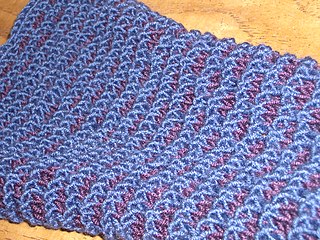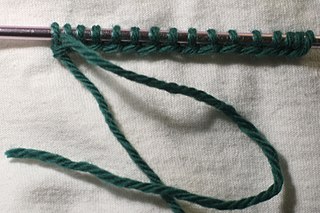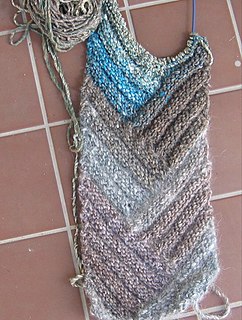
Crochet is a process of creating textiles by using a crochet hook to interlock loops of yarn, thread, or strands of other materials. The name is derived from the French term crochet, meaning 'small hook'. Hooks can be made from a variety of materials, such as metal, wood, bamboo, or plastic. The key difference between crochet and knitting, beyond the implements used for their production, is that each stitch in crochet is completed before the next one is begun, while knitting keeps many stitches open at a time. Some variant forms of crochet, such as Tunisian crochet and broomstick lace, do keep multiple crochet stitches open at a time.

Knitting is a method by which yarn is manipulated to create a textile, or fabric. It is used to create many types of garments. Knitting may be done by hand or by machine.

A knitting needle or knitting pin is a tool in hand-knitting to produce knitted fabrics. They generally have a long shaft and taper at their end, but they are not nearly as sharp as sewing needles. Their purpose is two-fold. The long shaft holds the active (unsecured) stitches of the fabric, to prevent them from unravelling, whereas the tapered ends are used to form new stitches. Most commonly, a new stitch is formed by inserting the tapered end through an active stitch, catching a loop of fresh yarn and drawing it through the stitch; this secures the initial stitch and forms a new active stitch in its place. In specialized forms of knitting the needle may be passed between active stitches being held on another needle, or indeed between/through inactive stitches that have been knit previously.
English knitting, also known as right-hand knitting or throwing, is a style of Western knitting where the yarn to be knit into the fabric is carried in the right hand. This style is prevalent throughout the English-speaking world, though it is by no means universal.

A knitting machine is a device used to create knitted fabrics in a semi or fully automated fashion. There are numerous types of knitting machines, ranging from simple spool or board templates with no moving parts to highly complex mechanisms controlled by electronics. All, however, produce various types of knitted fabrics, usually either flat or tubular, and of varying degrees of complexity. Pattern stitches can be selected by hand manipulation of the needles, push-buttons and dials, mechanical punch cards, or electronic pattern reading devices and computers.

A decrease in knitting is a reduction in the number of stitches, usually accomplished by suspending the stitch to be decreased from another existing stitch or by knitting it together with another stitch.

Slip-stitch knitting is a family of knitting techniques that uses slip stitches to make multiple fabrics simultaneously, to make extra-long stitches, and/or to carry over colors from an earlier row.

In knitting, an increase is the creation of one or more new stitches, which may be done by various methods that create distinctive effects in the fabric. Most knitting increases either lean towards the left or the right.

Drop-stitch knitting is a knitting technique for producing open, vertical stripes in a garment. The basic idea is to knit a solid fabric, then (deliberately) drop one or more stitches, producing a run in the fabric. The run will continue to the bottom edge of the garment, or until it encounters an increase, at which it stops.

In knitting, casting on is a family of techniques for adding new stitches that do not depend on earlier stitches, i.e., having an independent lower edge. In principle, it is the opposite of binding off, but the techniques involved are generally unrelated.
In knitting, binding off, or casting off, is a family of techniques for ending a column of stitches. Binding off is typically used to define the final edge of a knitted fabric, although it may also be used in other contexts, e.g., in making button holes. In principle, binding off is the opposite of casting on, but the techniques are generally not mirror images of one another. Sometimes, however, they can produce a mirror image appearance.
Knitting abbreviations are often used for brevity in describing knitting patterns.
In loop knitting, long, dangling loops are introduced into the middle of a knitted fabric or along an edge. The loops may appear singly or in large clusters. An overall array of such loops may be used to give a "shaggy" look to the fabric and/or make it warmer, e.g., tufting the inside of mittens. After they're made, the loops may be cut or left intact; two adjacent loops tied together in a bow-knot is an attractive pattern as well.

In knitting, welting is the horizontal analog of ribbing; that is, one or more horizontal rows of knit stitches alternating with one or more rows of purl stitches.
In knitting, a plaited stitch, also known as a twisted stitch, is a single knitted stitch that is twisted clockwise or counterclockwise, usually by one half-turn (180°) but sometimes by a full turn (360°) or more.

Brioche knitting is a family of knitting patterns involving tucked stitches, i.e., yarn overs that are knitted together with a slipped stitch from the previous row. Such stitches may also be made by knitting into the row below and dropping the stitch above.

In knitting, a short row is a row that is not fully knitted; the work is turned before reaching the end of the row. When working short rows, technique must be employed to prevent holes or gaps where the work is turned. There are several ways to do this. Among the most common are (1) Wrap and Turn, (2) German short rows and (3) Japanese short rows.
In knitting, buttonholes can be made in several ways.

Knitted fabric is a textile that results from knitting, the process of inter-looping of yarns or inter-meshing of loops. Its properties are distinct from woven fabric in that it is more flexible and can be more readily constructed into smaller pieces, making it ideal for socks and hats.
Hand knitting is a form of knitting, in which the knitted fabric is produced by hand using needles.














